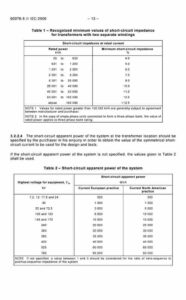
What is Dynamic Short Circuit Test on a Transformer?
Dynamic Short Circuit Test on a distribution and power Transformer is a critical procedure used in the field of electrical engineering to assess the performance and safety of transformers. This test, often referred to simply as a short Circuit Test, plays a vital role in ensuring the reliability of transformers, which are indispensable components in power distribution systems. In this article, we will delve into the intricacies of Dynamic Short Circuit Testing, its significance, the parameters it measures, practical considerations, and much more.
Understanding the Transformer Short Circuit Test
Basics of Transformer Operation
Before delving into the intricacies of Dynamic Short Circuit Testing, it’s essential to understand the fundamental operation of a transformer. A transformer is an electromagnetic device used to transfer electrical energy between two or more circuits through electromagnetic induction. It consists of primary and secondary windings wound around a common core. Transformers are crucial in stepping up or stepping down voltage levels in power transmission and distribution.
Short Circuit Test Setup
The Short Circuit Test involves connecting the low-voltage side (usually the secondary winding) of the transformer to a short circuit with shunt resistance according to transformer inductance capacity . This is achieved by connecting a low-resistance ammeter and a voltmeter to the secondary winding. The primary winding, on the other hand, is connected to a variable voltage source. This setup allows us to simulate the conditions of a short circuit.
Dynamic Short Circuit Test Procedure
During the Short Circuit Test, the primary voltage is gradually increased while monitoring the secondary current and voltage. The primary voltage is adjusted until the secondary current reaches a specific or calculated value as per the measured impedance. and also can say apply this short circuit current on the high voltage winding and target the required phase like (red, yellow, blue) and as well set the voltage tap position as per requirement. short circuit test performed mostly on three tap positions (1, 2, and 3) or as per the IEC-60076-5 guideline. Before the start of the test, measure the inductance on the required tap, and after every short, again measure the inductance and compare the tolerance value that is provided in IEC-60075-5. Tolerance is specified in IEC as per transformer winding type, for example, for circular windings of 2% and for foil windings of 5%. And the same tolerance in applied short circuit current is 10%, as is the same tolerance in DC component value. the table shown in the picture for DC component calculation. At this point, the test is conducted at the rated frequency, typically 50 or 60 Hz, depending on the region’s power system frequency. The test is performed with a low voltage on the primary side to prevent excessive heating and damage to the transformer.

The Significance of Short Circuit Testing
Dynamic Short Circuit Testing holds immense significance in the field of transformer testing for several reasons:
Ensuring Transformer Safety
One of the primary objectives of this test is to ensure the safety of the transformer. By subjecting it to short circuit conditions, the test helps identify potential weaknesses or faults that could lead to dangerous situations in real-world applications.
Detecting Potential Faults
Dynamic Short Circuit Testing is highly effective in detecting internal faults, such as winding insulation breakdowns, core defects, or loose connections. Identifying these issues early can prevent catastrophic transformer failures.
Compliance with Standards
Transformer manufacturers and utilities are required to adhere to strict industry standards and regulations. Dynamic Short Circuit Testing is often mandated to ensure compliance with safety and performance standards set by organizations like the IEEE (Institute of Electrical and Electronics Engineers) and the IEC-60076 (International Electrotechnical Commission) .
Key Parameters Measured in the Test
Several key parameters are measured during a Dynamic Short Circuit Test:
Short Circuit Impedance
The test helps determine the transformer’s short circuit impedance, a crucial parameter for fault analysis and protection coordination. Short circuit impedance indicates how the transformer behaves under short circuit conditions.

Voltage Drop and Regulation
By monitoring voltage drop and regulation during the test, engineers can assess the transformer’s ability to maintain voltage stability under heavy load conditions.
Losses and Efficiency
The test provides valuable data on the transformer’s losses and efficiency under short circuit conditions. This information is essential for evaluating the overall performance and energy efficiency of the transformer.
Practical Aspects of Dynamic Short Circuit Testing
Real-world Applications
Dynamic Short Circuit Testing is not limited to laboratory settings; it has real-world applications. Transformers in power substations, industrial facilities, and commercial buildings undergo this test to ensure their reliability in actual operating conditions.
Equipment and Safety Precautions
Conducting a Dynamic Short Circuit Test requires specialized equipment, including high-current generators and protective devices. Safety precautions are paramount, as the test involves high fault currents. Personnel involved in the test must follow strict safety protocols to prevent accidents.
Data Analysis and Interpretation
Analyzing the data obtained from the test is a complex process. Engineers use sophisticated software and mathematical models to interpret the results accurately. This analysis helps in identifying potential issues and making informed decisions regarding transformer maintenance or replacement.
Overcoming Challenges in the Test
Managing High Fault Currents
One of the challenges in Dynamic Short Circuit Testing is managing the high fault currents generated during the test. Specialized equipment and protective measures are required to ensure the safety of personnel and the transformer itself.
Reducing Test Duration
Shortening the test duration without compromising accuracy is a constant goal in transformer testing. Innovations in testing techniques and equipment have led to more efficient testing processes.
Data Accuracy and Precision
Achieving precise and accurate measurements is crucial in transformer testing. Factors such as instrument calibration and environmental conditions can impact the accuracy of test results.
Comparative Analysis with Other Transformer Tests
Short Circuit vs. Open Circuit Tests
Dynamic Short Circuit Testing differs from Open Circuit Testing in that it evaluates the transformer’s performance under load conditions, while Open Circuit Testing assesses its performance when no load is connected. Both tests provide valuable insights into transformer behavior but serve different purposes.
Short Circuit vs. Load Loss Tests
Load Loss Tests, also known as Copper Loss Tests, focus on measuring the transformer’s losses when operating at full load. These tests complement the information obtained from Dynamic Short Circuit Testing, providing a comprehensive view of transformer performance.
Industry Standards and Guidelines
Dynamic Short Circuit Testing is governed by a set of industry standards and guidelines to ensure consistency and safety in testing procedures. Some of the prominent standards include:
IEEE Standards
The Institute of Electrical and Electronics Engineers (IEEE) has established standards such as IEEE Std C57.12.90-2020, which provide detailed guidelines on the procedures and requirements for Dynamic Short Circuit Testing of transformers. Compliance with IEEE standards is essential for manufacturers and utilities to meet industry expectations.
IEC Standards
The International Electrotechnical Commission (IEC) has its own set of standards related to transformer testing, including IEC 60076-5:2016. These standards cover various aspects of transformer testing, including Short Circuit Testing, and are recognized worldwide for ensuring the quality and safety of transformers.
National and International Regulations
In addition to IEEE and IEC standards, various national and international regulations may apply depending on the location and intended use of the transformer. These regulations are in place to guarantee the safe and reliable operation of transformers in specific regions.
Case Studies and Real-Life Examples
Transformer Failures and Lessons Learned
Examining case studies of transformer failures can provide valuable insights into the importance of Dynamic Short testing. Instances of transformer failures due to undetected faults highlight the critical role this test plays in preventing costly and potentially catastrophic incidents.
Success Stories from Dynamic Short Circuit Testing
On the flip side, success stories from transformer testing demonstrate how early detection of issues through Dynamic Short Circuit Testing has saved both time and resources for organizations. These stories underscore the preventive and cost-saving aspects of this testing method.
Preparing for a Dynamic Short Circuit Test
Pre-Test Inspection
Before conducting a Dynamic Short Circuit Test, a thorough inspection of the transformer is necessary. This inspection includes checking for any visible defects, verifying the integrity of connections, and ensuring that safety features are in place and functional.
Test Planning and Documentation
Detailed planning is essential for a successful Dynamic Short Circuit Test. This includes specifying test parameters, selecting appropriate test equipment, and creating a comprehensive test plan. All test procedures and results should be documented meticulously for future reference and analysis.
Ensuring Personnel Safety
Safety should always be the top priority when conducting Dynamic Short testing. Proper training, personal protective equipment (PPE), and adherence to safety protocols are crucial to minimizing the risks associated with high fault currents.
Innovations in Dynamic Short Circuit Testing
Advanced Testing Techniques
Advancements in testing techniques, such as the use of digital instruments, have improved the accuracy and efficiency of Dynamic Short Circuit Testing. These innovations enable faster data collection and analysis, reducing testing time and costs.
Role of Technology in Transformer Testing
Technology, including artificial intelligence and data analytics, is playing an increasingly significant role in transformer testing. It allows for predictive maintenance based on historical test data and can help identify potential issues before they escalate.
Future Trends
The field of transformer testing is continuously evolving. Future trends may include the integration of sensors for real-time monitoring, enhanced diagnostic capabilities, and further automation of testing processes, making Dynamic Short Circuit Testing even more efficient and effective.
Conclusion
In conclusion, Dynamic Short Circuit Testing on transformers is a fundamental procedure for ensuring the safety, reliability, and compliance of these critical electrical devices. This article has explored the basics of this test, its significance, key parameters measured, practical considerations, and its role in transformer maintenance and safety. As technology continues to advance, the importance of Dynamic Short Circuit Testing in preventing transformer failures and optimizing their performance cannot be overstated.
Frequently Asked Questions (FAQs)
What is the purpose of a dynamic short circuit test on a transformer?
A dynamic short circuit test on a transformer is conducted to assess its performance, safety, and compliance with industry standards. It helps detect potential faults and weaknesses in the transformer under short circuit conditions.
How is a dynamic short circuit test different from other transformer tests?Unlike other tests, such as open circuit tests and load loss tests, dynamic short circuit testing evaluates how a transformer behaves under short circuit conditions, providing critical insights into its performance and safety.
What are the safety precautions for conducting a dynamic short circuit test?
Safety precautions include thorough personnel training, the use of personal protective equipment (PPE), adherence to safety protocols, and ensuring that the testing environment is secure to manage high fault currents.
Can you provide an example of a transformer failure detected through this test?
Certainly, there have been cases where undetected faults in transformers led to catastrophic failures. One example is the failure of a power substation transformer due to insulation breakdown, which was identified through dynamic short circuit testing before it could cause a blackout.
What role does dynamic short circuit testing play in ensuring transformer reliability?
Dynamic short circuit testing plays a crucial role in ensuring transformer reliability by identifying potential issues, verifying compliance with industry standards, and allowing for preventive maintenance. This, in turn, extends the lifespan of transformers and minimizes unexpected failures.

Leave a Reply